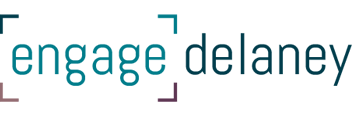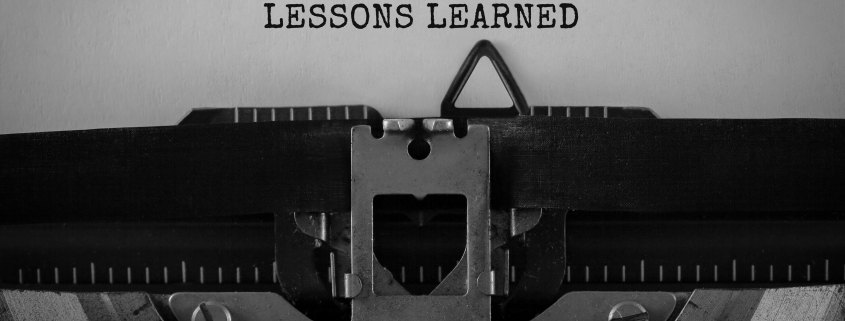Things I Learned from My Mom and Dad
by Valerie Delaney, Principal, Learning and Development
We’ve all seen that cute poster titled “Things I Learned in Kindergarten”.
Well, this is the Delaney version called, “Things I Learned from My Mom and Dad”.
These gems really have been hitting home during the days of COVID-19, and with such frequency I feel compelled to comment on them. Turns out Mom and Dad were wiser than we maybe ever admitted. Isn’t that always the case!
Here’s my take – from the personal perspective and the engagement perspective. Hope you enjoy.
- You don’t know what you don’t know.
Usually mom would say this in the context of a news article she had read or a story she had heard. She remained open to learning new things up until the end of her long life, while not forgetting her basic truths. Her acceptance and courage in the face of new information continues to inspire me, maybe even more now than ever before.
There are so many unknowns as we collectively navigate the COVID-19 waters that I find myself thinking a lot about what we don’t know, which makes me feel not very brave at all.
Something to think about as we plan our engagements. What don’t we know? We hear clients and practitioners talk sometimes about outrage and saboteurs at the engagement table. How does that happen? It happens by thinking you know it all, when you don’t. Don’t want it to happen? Practice good pre-engagement by:
- Beating the bushes for those who are impacted, including the seldom heard voices, and also those positively impacted
- Reaching out through pre-engagement interviews to learn about impacts and those impacted
- Giving yourself time to extend the invitation to participate as widely as possible
- Building relationships early in the process
- Creating diverse advisory teams made up of those impacted and with lived experience
- Asking people how they want to be engaged and working to collaborate when you can
- Listening because you don’t know what you don’t know and you shouldn’t guess
That’s how you’ll find out what you don’t know and be better positioned to plan an engagement process that will be inclusive and collaborative, minimizing the risk of outrage.
- All being well.
It didn’t matter if we were inviting mom to Sunday dinner that weekend, or to the cottage in a few weeks, she would inevitably say, “Sure, all being well.” Translated, this actually meant, “If I’m still around.” It made us chuckle, but really, she was right. She knew to make plans, but to not get too attached to them. Who amongst us ever expected to see our lives and plans thrown into the chaos we are seeing during this pandemic? Certainly not me.
When it comes to engagements, we like to say, “Create an environment of no surprises.” We talk about elegant design and great execution, but COVID-19 has turned a lot of our truisms on end. Our best plans were great – all being well, but things are not well right now. We, and our clients and colleagues, are adjusting rapidly to a new operating environment and considering:
- Do we still have a project?
- Can our engagement plans be modified, in order to move the process forward?
- What shifts in technology must we make?
- Should anyone be engaging in the middle of a pandemic? Does anyone care right now? What will people say/remember for having been engaged at this time – for good or bad?
- How can we support our clients whose resources to engage have been drastically reduced, but who still must engage?
- What does this mean for engagement plans in the “new normal”? Where can we build in risk-mitigation measures and technologies for national or global events such as we are in now?
- Don’t put off doing to tomorrow what you could be doing today.
This one really annoyed me and was a favourite of my dad. Now, the fact he was in the military for 30 years and a veteran no doubt explains where he was coming from. You wanted supplies to get to the troops? You better get right on that because who knew what was coming down the pipe. If you were a kid, though, who just wanted to chill out for a bit before doing that chore – enough said. COVID-19 has reminded me to do what needs to be done right away – like getting to the bank before our local branch shut down operations, getting Rosie’s (office dog) tick medication curbside and ordering a bottle or two of the best of our local winery. I really wish I had stocked up on hair colour!!!
On the engagement front, we all make time to build out a work plan, draft the engagement and communications plans, do the pre-engagement work, and all the rest of it. But what often happens is the planning and pre-engagement efforts take far more time than expected and the active engagement time arrives in a compressed – even “hurry up and get it done” – kind of way. It’s important to look at engagement activities as both sequential and essential. Yes, you are building relationships and gathering information during the pre-engagement period, but you are also anticipating communication tools, techniques, and logistics of the active engagement period.
What can you do to keep your engagement on track and on time?
- Have a project charter with roles and responsibilities. Get sign off. Agree to reporting timelines, including weekly budget updates.
- Failing to plan is planning to fail. Complete the engagement plan early and get it approved and then actually follow it.
- Engage early and often. Participants need time to understand the dimensions of the discussion and their role in it. Please don’t assume that people are bored and just waiting for you to engage them. It takes time.
- Share information early at the INFORM level so that subsequent conversations yield meaningful input that is well informed and directly related to the project.
- It can always be worse.
Ok. I just threw this in here to scare you, but given I grew up with this, it’s only fair. And, actually again – too true. In our family, we talked recently about the wild fire season during COVID-19 and what that might look like. How does one evacuate large numbers of people to social-distancing safe evacuation points? Here we are. The first large wild fire of the season and an evacuation was underway in BC, just north of Squamish, on the very day a province-wide fire ban begins.
When it comes to any engagement – in-person and virtual – remember, difficult times can be followed by more difficult times. Some thoughts to consider to avoid that happening to you, or to fix things when the going gets rough, include the following:
- Have a back-up plan – for the technology, for the print materials, for the venue – for anything that is critical to the success of your engagement. The planning team mantra can well be, “What’s the worst thing that can happen?” “What’s our fear factor?” Then, you get to plan for it.
- Worried about high emotion during an in-person session? Get out in front of it. We’ve done things like “walk abouts”, lemonade stands and coffee klatches to meet and talk with citizens, to get a pulse on what they are feeling and thinking. Work hard to avoid being surprised or side swiped by issues or participants unknown to you.
- Talk to key stakeholders and ask, “Why are people angry?” Take those concerns (let’s just call them fears because that’s what they usually are) and initiate a conversation about how they can be addressed – together.
- Ask participants to RSVP, so you know who/how many are attending and so you can add sessions or additional space.
- Really worried? It’s up to you to ensure the safety of staff and participants; yes, sometimes, you have to put security measures in place.
- If you make a mistake – apologize, and please, can we all stop using the words “mis-spoke” or mis-step? Say, “I made a mistake and I am sorry. Here’s what we can do to fix this. Will that work? What else needs to happen?”
Thanks, Mom and Dad. You were right – again.




